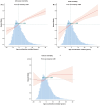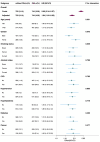Association between phenotypic age and mortality risk in individuals with obesity: a retrospective cohort study
- PMID: 39717032
- PMCID: PMC11663737
- DOI: 10.3389/fpubh.2024.1505066
Association between phenotypic age and mortality risk in individuals with obesity: a retrospective cohort study
Abstract
Objective: This study investigates the association between phenotypic age acceleration (PAA) and all-cause and cause-specific mortality in obese individuals.
Methods: Data were drawn from the National Health and Nutrition Examination Survey (NHANES) between 1999 and 2018, including 9,925 obese adults (BMI ≥ 30 kg/m2). PAA, defined as phenotypic age exceeding chronological age, was assessed using clinical biomarkers. Kaplan-Meier survival analysis and Cox proportional hazards models were used to assess the relationship between PAA and all-cause, cardiovascular, and cancer mortality, adjusting for covariates such as age, gender, race, lifestyle, and health status. Subgroup and sensitivity analyses were performed to ensure the robustness of the findings.
Results: During a median follow-up of 10.6 years, 1,537 deaths were recorded, including 419 from cardiovascular disease and 357 from cancer. PAA was significantly associated with all-cause mortality (HR = 1.84, 95% CI: 1.64-2.06), cardiovascular mortality (HR = 1.86, 95% CI: 1.50-2.31), and cancer mortality (HR = 1.47, 95% CI: 1.17-1.85). These associations remained significant after adjusting for multiple variables, and sensitivity analyses confirmed the robustness of the results.
Conclusion: PAA is an independent predictor of all-cause, cardiovascular, and cancer mortality in obese individuals. This study highlights the importance of PAA in mortality risk assessment and health management in the obese population.
Keywords: NHANES; all-cause mortality; cancer; cardiovascular disease; obesity; phenotypic age acceleration.
Copyright © 2024 Huang, Zhou, Huang, Wang, Liu and Liu.
Conflict of interest statement
The authors declare that the research was conducted in the absence of any commercial or financial relationships that could be construed as a potential conflict of interest.
Figures




Similar articles
-
Association of phenotypic age acceleration with all-cause and cause-specific mortality among U.S. cancer survivors: a retrospective cohort study.BMC Cancer. 2025 Feb 25;25(1):338. doi: 10.1186/s12885-025-13760-6. BMC Cancer. 2025. PMID: 40001013 Free PMC article.
-
Association of N-terminal pro-B natriuretic peptide with all-cause mortality and cardiovascular mortality in obese and non-obese populations and the development of a machine learning prediction model: National Health and Nutrition Examination Survey (NHANES) 1999-2004.Diabetes Obes Metab. 2024 Dec;26(12):5609-5620. doi: 10.1111/dom.15927. Epub 2024 Sep 6. Diabetes Obes Metab. 2024. PMID: 39239686
-
Association between cardiometabolic index and all-cause and cause-specific mortality among the general population: NHANES 1999-2018.Lipids Health Dis. 2024 Dec 27;23(1):425. doi: 10.1186/s12944-024-02408-2. Lipids Health Dis. 2024. PMID: 39731068 Free PMC article.
-
Remnant cholesterol inflammatory index and its association with all-cause and cause-specific mortality in middle-aged and elderly populations: evidence from US and Chinese national population surveys.Lipids Health Dis. 2025 Apr 24;24(1):155. doi: 10.1186/s12944-025-02580-z. Lipids Health Dis. 2025. PMID: 40275392 Free PMC article.
-
Life's Essential 8 and Mortality in US Adults With Obesity: A Cohort Study.Endocr Pract. 2024 Nov;30(11):1089-1096. doi: 10.1016/j.eprac.2024.08.015. Epub 2024 Sep 4. Endocr Pract. 2024. PMID: 39241965
References
-
- Okolo I, Mahmood AT. Obesity and cardiovascular disease in reproductive health. Obes Gynecol. (2020) 28:255–63. 10.1016/B978-0-12-817919-2.00028-0 - DOI
MeSH terms
LinkOut - more resources
Full Text Sources
Medical

